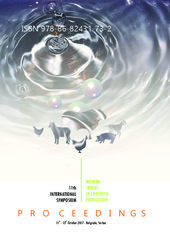Приказ основних података о документу
DAIRY COWS HEALTH PARAMETERS IN DIFFERENT SEASON - A WELFARE APPROACH
| dc.creator | Ostojić Andrić, Dušica | |
| dc.creator | Hristov, Slavča | |
| dc.creator | Petrović, Milan M. | |
| dc.creator | Pantelić, Vlada | |
| dc.creator | Nikšić, Dragan | |
| dc.creator | Caro Petrović, Violeta | |
| dc.creator | Stanojković, Aleksandar | |
| dc.date.accessioned | 2020-05-22T11:28:28Z | |
| dc.date.available | 2020-05-22T11:28:28Z | |
| dc.date.issued | 2017 | |
| dc.identifier.isbn | 978-86-82431-73-2 | |
| dc.identifier.uri | http://r.istocar.bg.ac.rs/handle/123456789/700 | |
| dc.description.abstract | The aim of the research was to determine whether the frequency of certain injuries and diseases of cows as important parameters for ensuring their welfare varies considerably depending on the growing season (summer/winter). The research was conducted by Welfare Quality Assessment Protocol for Dairy Cows (2009) on total of 16 dairy farms (N=4.833 cows), wherein the provision of good health was descriptively categorized as unacceptable, acceptable, enhanced and excellent, according to calculated score (0-100 points).The air temperature of given location was recorded during each farm visit, so the average temperature of conducted assessment for specific season, served as additional indicator of dairy cows’ thermal comfort. The results of the study showed that the effect of the season on the incidence of injuries and illness was not significant (p> 0.05), but certain disorders were more frequent in one of the seasons. In the summer season, mastitis (2.63%), diarrhea (2.31%), discharge from the eye and nose (6.24% and 1.69%) were more frequent, and in the winter season lameness (27.78%) , tachypnoea (0.13%), and vaginal discharge (1.73%). Relying on welfare standards, it can be concluded that the parameters tested do not represent an alarming risk for the welfare of raised animals with the exception of mastitis rates and ocular discharge in the summer period. However, the overall health of dairy cows in both seasons is considered acceptable (in average 40 from 100 points) indicating that only minimal requirements for ensuring well-being are met and that there is a need to improve the health situation. Given that related studies have shown a low level of protection of the comfort of the examined animals as well as its significant influence on the provision of thermal comfort and health of cows, the recommendations are directed primarily at ensuring appropriate conditions of keeping with adequate and continuous health control of the herd | en |
| dc.language.iso | en | sr |
| dc.publisher | Institute for Animal Husbandry, Belgrade-Zemun | sr |
| dc.relation | info:eu-repo/grantAgreement/MESTD/Technological Development (TD or TR)/31053/RS//"> | sr |
| dc.rights | openAccess | sr |
| dc.rights.uri | https://creativecommons.org/licenses/by/4.0/ | |
| dc.source | Proceedings of the 11th International Symposium Modern Trends in Livestock Production, Belgrade, Serbia, October 11-13, 2017 | sr |
| dc.subject | dairy cows | sr |
| dc.subject | season | sr |
| dc.subject | health | sr |
| dc.subject | welfare | sr |
| dc.subject | parameters | sr |
| dc.subject | thermal comfort | sr |
| dc.title | DAIRY COWS HEALTH PARAMETERS IN DIFFERENT SEASON - A WELFARE APPROACH | en |
| dc.type | conferenceObject | sr |
| dc.rights.license | BY | sr |
| dcterms.abstract | Остојић-Aндрић, Душица; Пантелић, Влада; Христов, Славча; Станојковић, Aлександар; Петровић, Милан М.; Царо-Петровић, Виолета; Никшић, Драган; | |
| dc.citation.spage | 268 | |
| dc.citation.epage | 277 | |
| dc.identifier.rcub | https://hdl.handle.net/21.15107/rcub_ristocar_700 | |
| dc.identifier.fulltext | http://r.istocar.bg.ac.rs/bitstream/id/3612/bitstream_3612.pdf | |
| dc.type.version | publishedVersion | sr |


